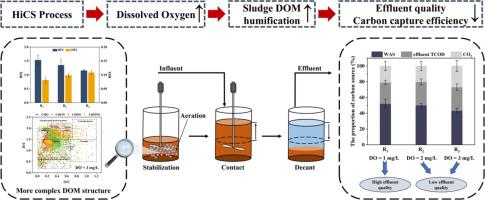当前位置:
X-MOL 学术
›
Water Res.
›
论文详情
Our official English website, www.x-mol.net, welcomes your
feedback! (Note: you will need to create a separate account there.)
The nexus between aeration intensity and organic carbon capture in contact-stabilization process: Insights from molecular structure transition of dissolved organic matters
Water Research ( IF 11.4 ) Pub Date : 2024-11-07 , DOI: 10.1016/j.watres.2024.122769 Shi-Xu Wang, Wei Yao, Chao-Xi Yang, Wen-Long He, Jing Li, Bao-Cheng Huang, Ren-Cun Jin
Water Research ( IF 11.4 ) Pub Date : 2024-11-07 , DOI: 10.1016/j.watres.2024.122769 Shi-Xu Wang, Wei Yao, Chao-Xi Yang, Wen-Long He, Jing Li, Bao-Cheng Huang, Ren-Cun Jin

|
Traditional energy-intensive pollution control pattern poses great challenges to the sustainable development of urban cities, necessitating the implementation of more compact and cost-effective biological treatment technology. High-rate contact stabilization (HiCS) process can effectively capture low-concentration organic carbon matters from municipal wastewater. However, the role of dissolved oxygen (DO) concentration at stabilization phase-a critical determinant of carbon capture efficiency-remains poorly understood, thus hindering its operation optimization and application. This work investigated the impact of DO content at the stabilization phase on the effluent quality and carbon capture efficiency of HiCS process from the perspectives of sludge dissolved organic matter (DOM) composition and microbial metabolism activity changes. The results showed that optimal carbon capture efficiency (52.1 %) and the lowest effluent chemical oxygen demand concentration were achieved at a DO concentration of 1 mg/L. Elevated DO levels would increase the aromaticity of DOM in sludge, rendering it more recalcitrant to microbial degradation. In addition, higher DO concentration induced a metabolic shift towards endogenous respiration among the microbial community, leading to the increased release of DOM and microbial metabolites, which in turn deteriorated the effluent quality. The findings of this work highlight the necessity of controlling appropriate aeration intensity when applying HiCS in practical application, to both effectively minimize organic carbon mineralization and operational energy consumption while without sacrificing pollutant removal performance.
中文翻译:

接触稳定过程中曝气强度与有机碳捕获之间的联系:来自溶解有机物分子结构转变的见解
传统的能源密集型污染治理模式对城市的可持续发展提出了巨大挑战,需要实施更紧凑、更具成本效益的生物处理技术。高速接触稳定 (HiCS) 工艺可以有效地捕获城市污水中的低浓度有机碳物质。然而,溶解氧 (DO) 浓度在稳定阶段的作用——碳捕集效率的关键决定因素——仍然知之甚少,从而阻碍了其运行优化和应用。本研究从污泥溶解有机质 (DOM) 组成和微生物代谢活性变化的角度研究了稳定阶段 DO 含量对 HiCS 工艺出水质量和碳捕获效率的影响。结果表明,在 DO 浓度为 1 mg/L 时,实现了最佳的碳捕获效率 (52.1%) 和最低的出水化学需氧量浓度。升高的 DO 水平会增加污泥中 DOM 的芳香性,使其更耐微生物降解。此外,较高的 DO 浓度诱导微生物群落代谢转向内源性呼吸,导致 DOM 和微生物代谢物的释放增加,进而恶化了出水质量。这项工作的结果强调了在实际应用中应用 HiCS 时控制适当曝气强度的必要性,以有效减少有机碳矿化和运营能耗,同时不牺牲污染物去除性能。
更新日期:2024-11-07
中文翻译:

接触稳定过程中曝气强度与有机碳捕获之间的联系:来自溶解有机物分子结构转变的见解
传统的能源密集型污染治理模式对城市的可持续发展提出了巨大挑战,需要实施更紧凑、更具成本效益的生物处理技术。高速接触稳定 (HiCS) 工艺可以有效地捕获城市污水中的低浓度有机碳物质。然而,溶解氧 (DO) 浓度在稳定阶段的作用——碳捕集效率的关键决定因素——仍然知之甚少,从而阻碍了其运行优化和应用。本研究从污泥溶解有机质 (DOM) 组成和微生物代谢活性变化的角度研究了稳定阶段 DO 含量对 HiCS 工艺出水质量和碳捕获效率的影响。结果表明,在 DO 浓度为 1 mg/L 时,实现了最佳的碳捕获效率 (52.1%) 和最低的出水化学需氧量浓度。升高的 DO 水平会增加污泥中 DOM 的芳香性,使其更耐微生物降解。此外,较高的 DO 浓度诱导微生物群落代谢转向内源性呼吸,导致 DOM 和微生物代谢物的释放增加,进而恶化了出水质量。这项工作的结果强调了在实际应用中应用 HiCS 时控制适当曝气强度的必要性,以有效减少有机碳矿化和运营能耗,同时不牺牲污染物去除性能。


















































 京公网安备 11010802027423号
京公网安备 11010802027423号